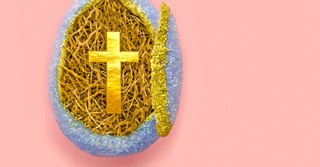Why Is the Cross Associated with Easter?
Share

Compared to Easter bunnies, spring flowers, and candy, the symbol of the cross could be seen as a bit gruesome and not kid-friendly. But as Christians, we know that although the cross symbolizes an excruciating death, it also symbolizes a beautiful sacrifice and a love that we could never fathom the riches of.
But why is the cross associated with Easter? Why did Christians choose the cross as the symbol for their biggest celebration of the year? Let’s read on to learn about the origins of this symbol, and why we Christians use it while celebrating Easter.
Photo credit: ©Getty Images/didoi
Why Do We See So Many Crosses at Easter Time?

Easter is the celebration of Jesus’ death, burial, and resurrection – and therefore becoming the Savior for all who believe in him, making eternal life possible for all of God’s people. The way that Jesus gave his life was through dying on the cross.
John 19:17-18 chronicles that. “Carrying his own cross, he went out to the place of the Skull (which in Aramaic is called Golgotha). There they crucified him, and with him two others — one on each side and Jesus in the middle.”
In Jesus’ time, in the Roman Empire, being crucified was a shameful way to be executed. The types of people who were typically crucified were “...soldiers who abandoned their service without authorization, non-Roman criminals, slaves, militants, rebels…Typical victims of crucifixion were accused robbers…”
Jesus was crucified because he was considered by the Roman government to be a rebel. He died a common criminal’s death, even though he did nothing wrong. And he did it for us.
Interestingly, the cross was not always the major symbol of Christianity. Other symbols preceded it, like the dove, the lyre, and the ichthus (the outline of the fish). The cross was not a part of Christian iconography until the 4th century, first appearing as an empty cross. Then, in the 6th century, crucifixes with Jesus’ body on it appeared and spread.
As Easter is a time to remember Jesus’ great sacrifice, it makes sense that the method by which he died is used as the symbol to remember his death.
Photo credit: ©Getty Images/POMACHKA
Why Was Jesus Crucified?

Although crucifixion, or dying on a tree, was a popular execution method by Jesus’ lifetime, it is actually deeply symbolic that Jesus died on the cross. The symbol of trees is used in stunning ways throughout the Bible, and it is very telling that the New Testament describes Jesus dying on a tree, like in 1 Peter 2:24a: “He himself bore our sins in his body on the tree…”
The Bible Project helps describe the symbolism of Jesus dying on a tree this way: “That is to say, he did what the first humans failed to do in choosing to eat from the other tree in the garden and define good and evil for themselves. Jesus’ reliance and obedience also accomplished what God’s chosen people couldn’t do — channel abundant life to the nations. The cross is actually referred to as a tree in the New Testament (Acts 10:38-40; Galatians 3:13-14, 1 Peter 2:21-25)!”
It is so beautiful and astounding that God was able to weave Jesus’ timeline with the timeline of the popularity of crucifixion in order to make this symbol come alive. Of course, crucifixion is not a desirable thing that God outright approves of – but the fact that he was able to place Jesus at just the right time shows his power and sovereignty.
1 Peter 2:24 finishes by telling us why Jesus was crucified: “...that we might die to sin and live to righteousness. By his wounds you have been healed.” This is why Jesus had to be crucified, so that we could die to sin and be healed.
Colossians 2:11b-15 puts it this way:
“Your whole self ruled by the flesh was put off when you were circumcised by Christ, having been buried with him in baptism, in which you were also raised with him through your faith in the working of God, who raised him from the dead.
“When you were dead in your sins and in the uncircumcision of your flesh, God made you alive with Christ. He forgave us all our sins, having canceled the charge of our legal indebtedness, which stood against us and condemned us; he has taken it away, nailing it to the cross. And having disarmed the powers and authorities, he made a public spectacle of them, triumphing over them by the cross.”
Jesus’ death and resurrection made it possible for our own death to sin and resurrection into eternal life. He became the perfect sacrifice made on our behalf (Hebrews 9:13-14) and in doing so, gifted us eternal life (John 3:16).
Jesus was crucified to fulfill prophecy, to disarm the powers and authorities of the world, and to get rid of any barrier between us and God.
Photo credit: ©Getty Images/jchizhe
Is It Good to Remember the Cross at Easter?

Remembering God’s actions in our lives is always a good thing! The word “remember” is found in the Bible over 150 times. We are encouraged to remember so often because God knows our human nature to forget his goodness when things are tough.
It is very good to remember Jesus’ sacrifice as often as we can, not just at Easter. Luke 22:19-20 tells us from Jesus’ own mouth: “And he took bread, gave thanks and broke it, and gave it to them, saying, ‘This is my body given for you; do this in remembrance of me.’ In the same way, after the supper he took the cup, saying, ‘This cup is the new covenant in my blood, which is poured out for you.’”
It is good for us to remember Jesus’ sacrifice so that we can hold onto the profound love that God and Jesus have for us, and remember the consequences of our sin. But that isn’t the only part of the story that is worth remembering.
According to communion, Jesus wants us to remember his death for us (the wine). But he also wants us to remember his life (the bread)!
I think it is important not just to remember Jesus at the cross, but to remember that the tomb he was buried in is also empty. Jesus didn’t just die for us; he rose again!
Right before Jesus gave up his spirit, he said the profound words “It is finished,” (John 19:30). And, after all, 1 Corinthians 15:13-14 highlights the importance of the resurrection with “...if Christ has not been raised, our preaching is useless and so is your faith.” Jesus doesn’t want us solely focused on our sin or his death.
Thanks be to God, that isn’t the end of the story!
Photo credit: ©Getty Images/dndavis
What Other Symbols Do We See at Easter, and Why?

One fun and educational Easter tradition for Christians is something called “Resurrection Eggs.” Instead of, or in addition to, using Easter eggs just to fill with candy, you can fill plastic eggs with little symbols of different aspects of the Easter story. These are a great way to learn about other Easter symbols.
Common Easter symbols apart from the cross include:
- Palm Branches: from when Jesus rode into Jerusalem on a donkey and was greeted by people laying down palm branches and their coats, welcoming him as their Hosanna (Matthew 21:1-11; Mark 11:1-11; Luke 19:28-34; and John 12:12-15).
- Bread and Wine: from the Passover meal where Jesus introduces the sacrament of communion (Luke 22:20; Matt. 26:28; Luke 22:19; 1 Cor. 11:26).
- Crown of Thorns: from when Jesus was given a crown of thorns after he was flogged by Roman soldiers, mocking him for being the King of the Jews (Matthew 27:27-31; Mark 15:16-20; John 19:1-3).
- Pieces of Silver: from when Jesus was betrayed by Judas for 30 pieces of silver (Matthew 26:14-15; Mark 14:10-11; Luke 22:3-5).
- The Empty Tomb: from when the tomb was found with the stone rolled away, and Jesus was nowhere to be found because he was risen from the dead (Matthew 28:1,5-7; Mark 16:1-6; Luke 24:1-6; John 20:1-2).
Each of these symbols carries a deep and rich part of the story of Jesus, and each warrant their own research on your own!
The cross is a very important symbol of Easter. In its simple shape, we are reminded of so many profound truths: thousands of years of prophecy, God’s sovereignty, and Jesus’ excruciating death – but most importantly, God’s great, great love for us shown through Jesus’ sacrifice.
Easter is a wonderful time of remembering Jesus. Not only our sin and his death, but his resurrection as well, that graciously paves our way to paradise.
Sources
History of Crucifixion Explained
Cross was not always symbol of Christianity
The Tree of Life: Lost but Not Forgotten
How to Make Resurrection Eggs a Special Part of Your Easter
Related articles
6 Beautiful Truths about the Crucifixion
Why Did Pontius Pilate Allow Jesus to Be Crucified?
Why Did Jesus Have to Die for Our Sins on the Cross?
Photo credit: ©Getty Images/Light Field Studios
The views expressed in this commentary do not necessarily reflect those of CrosswalkHeadlines.
Kelly-Jayne McGlynn is a former editor at Crosswalk.com. She sees the act of expression, whether through writing or art, as a way to co-create with God and experience him deeper. Check out her handmade earrings on Instagram and her website for more of her thoughts on connecting with God through creative endeavors.